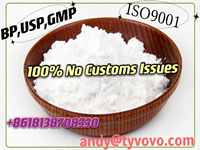
Lidocaine HCL Powder
English name: Linocaine hydrochloride
CAS No.: 6108-05-0
Molecular formula: C14H25ClN2O2
Molecular weight: 288.81
EINECS number: 612-079-4
Melting point 75-79 ° C
Storage conditions 2-8 ° C
Uses: Lidoca hydrochloride is a local anesthetic because of amide. After blood absorption or intravenous administration, it has obvious excitatory and inhibitory biphasic effects on the central nervous system, and can have no pioneering excitement. When the blood concentration is low, analgesia and lethargy and pain threshold increase; Large, active or toxic, anticonvulsant in sub-poisoning plasma concentrations
Uses: local anesthetics. Local anesthetic intensity: tetracaine>tetracaine hcl>lidocaine>lidcaine hcl> benzocaine > procaine>procaine hcl, but there are corresponding side effects. Mainly used for surface anesthesia of the eyes, nose, throat and urinary tract. It can cause convulsions after absorption, and then it is converted to respiratory depression.
CAS No.: 6108-05-0
Molecular formula: C14H25ClN2O2
Molecular weight: 288.81
EINECS number: 612-079-4
Melting point 75-79 ° C
Storage conditions 2-8 ° C
Uses: Lidoca hydrochloride is a local anesthetic because of amide. After blood absorption or intravenous administration, it has obvious excitatory and inhibitory biphasic effects on the central nervous system, and can have no pioneering excitement. When the blood concentration is low, analgesia and lethargy and pain threshold increase; Large, active or toxic, anticonvulsant in sub-poisoning plasma concentrations
Uses: local anesthetics. Local anesthetic intensity: tetracaine>tetracaine hcl>lidocaine>lidcaine hcl> benzocaine > procaine>procaine hcl, but there are corresponding side effects. Mainly used for surface anesthesia of the eyes, nose, throat and urinary tract. It can cause convulsions after absorption, and then it is converted to respiratory depression.
Certificate
- BP
- ISO9001
- USP
- GMP
Main Products
Tetracaine lidocaine procaine benzocaine phenacetin
